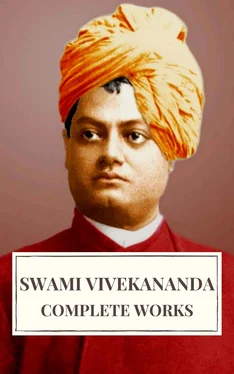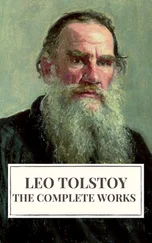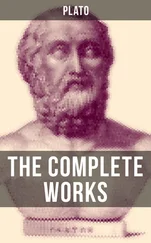There is a sage in India, a great Yogi, one of the most wonderful men I have ever seen in my life. He is a peculiar man, he will not teach any one; if you ask him a question he will not answer. It is too much for him to take up the position of a teacher, he will not do it. If you ask a question, and wait for some days, in the course of conversation he will bring up the subject, and wonderful light will he throw on it. He told me once the secret of work, “Let the end and the means be joined into one.” When you are doing any work, do not think of anything beyond. Do it as worship, as the highest worship, and devote your whole life to it for the time being. Thus, in the story, the Vyadha and the woman did their duty with cheerfulness and whole-heartedness; and the result was that they became illuminated, clearly showing that the right performance of the duties of any station in life, without attachment to results, leads us to the highest realisation of the perfection of the soul.
It is the worker who is attached to results that grumbles about the nature of the duty which has fallen to his lot; to the unattached worker all duties are equally good, and form efficient instruments with which selfishness and sensuality may be killed, and the freedom of the soul secured. We are all apt to think too highly of ourselves. Our duties are determined by our desires to a much larger extent than we are willing to grant. Competition rouses envy, and it kills the kindliness of the heart. To the grumbler all duties are distasteful; nothing will ever satisfy him, and his whole life is doomed to prove a failure. Let us work on, doing as we go whatever happens to be our duty, and being ever ready to put our shoulders to the wheel. Then surely shall we see the Light!
Chapter V. We Help Ourselves, Not The World
Before considering further how devotion to duty helps us in our spiritual progress, let me place before you in a brief compass another aspect of what we in India mean by Karma. In every religion there are three parts: philosophy, mythology, and ritual. Philosophy of course is the essence of every religion; mythology explains and illustrates it by means of the more or less legendary lives of great men, stories and fables of wonderful things, and so on; ritual gives to that philosophy a still more concrete form, so that every one may grasp it — ritual is in fact concretised philosophy. This ritual is Karma; it is necessary in every religion, because most of us cannot understand abstract spiritual things until we grow much spiritually. It is easy for men to think that they can understand anything; but when it comes to practical experience, they find that abstract ideas are often very hard to comprehend. Therefore symbols are of great help, and we cannot dispense with the symbolical method of putting things before us. From time immemorial symbols have been used by all kinds of religions. In one sense we cannot think but in symbols; words themselves are symbols of thought. In another sense everything in the universe may be looked upon as a symbol. The whole universe is a symbol, and God is the essence behind. This kind of symbology is not simply the creation of man; it is not that certain people belonging to a religion sit down together and think out certain symbols, and bring them into existence out of their own minds. The symbols of religion have a natural growth. Otherwise, why is it that certain symbols are associated with certain ideas in the mind of almost every one? Certain symbols are universally prevalent. Many of you may think that the cross first came into existence as a symbol in connection with the Christian religion, but as a matter of fact it existed before Christianity was, before Moses was born, before the Vedas were given out, before there was any human record of human things. The cross may be found to have been in existence among the Aztecs and the Phoenicians; every race seems to have had the cross. Again, the symbol of the crucified Saviour, of a man crucified upon a cross, appears to have been known to almost every nation. The circle has been a great symbol throughout the world. Then there is the most universal of all symbols, the Swastika.  At one time it was thought that the Buddhists carried it all over the world with them, but it has been found out that ages before Buddhism it was used among nations. In Old Babylon and in Egypt it was to be found. What does this show? All these symbols could not have been purely conventional. There must be some reason for them; some natural association between them and the human mind. Language is not the result of convention; it is not that people ever agreed to represent certain ideas by certain words; there never was an idea without a corresponding word or a word without a corresponding idea; ideas and words are in their nature inseparable. The symbols to represent ideas may be sound symbols or colour symbols. Deaf and dumb people have to think with other than sound symbols. Every thought in the mind has a form as its counterpart. This is called in Sanskrit philosophy Nâma-Rupa — name and form. It is as impossible to create by convention a system of symbols as it is to create a language. In the world’s ritualistic symbols we have an expression of the religious thought of humanity. It is easy to say that there is no use of rituals and temples and all such paraphernalia; every baby says that in modern times. But it must be easy for all to see that those who worship inside a temple are in many respects different from those who will not worship there. Therefore the association of particular temples, rituals, and other concrete forms with particular religions has a tendency to bring into the minds of the followers of those religions the thoughts for which those concrete things stand as symbols; and it is not wise to ignore rituals and symbology altogether. The study and practice of these things form naturally a part of Karma-Yoga.
At one time it was thought that the Buddhists carried it all over the world with them, but it has been found out that ages before Buddhism it was used among nations. In Old Babylon and in Egypt it was to be found. What does this show? All these symbols could not have been purely conventional. There must be some reason for them; some natural association between them and the human mind. Language is not the result of convention; it is not that people ever agreed to represent certain ideas by certain words; there never was an idea without a corresponding word or a word without a corresponding idea; ideas and words are in their nature inseparable. The symbols to represent ideas may be sound symbols or colour symbols. Deaf and dumb people have to think with other than sound symbols. Every thought in the mind has a form as its counterpart. This is called in Sanskrit philosophy Nâma-Rupa — name and form. It is as impossible to create by convention a system of symbols as it is to create a language. In the world’s ritualistic symbols we have an expression of the religious thought of humanity. It is easy to say that there is no use of rituals and temples and all such paraphernalia; every baby says that in modern times. But it must be easy for all to see that those who worship inside a temple are in many respects different from those who will not worship there. Therefore the association of particular temples, rituals, and other concrete forms with particular religions has a tendency to bring into the minds of the followers of those religions the thoughts for which those concrete things stand as symbols; and it is not wise to ignore rituals and symbology altogether. The study and practice of these things form naturally a part of Karma-Yoga.
There are many other aspects of this science of work. One among them is to know the relation between thought and word and what can be achieved by the power of the word. In every religion the power of the word is recognised, so much so that in some of them creation itself is said to have come out of the word. The external aspect of the thought of God is the Word, and as God thought and willed before He created, creation came out of the Word. In this stress and hurry of our materialistic life, our nerves lose sensibility and become hardened. The older we grow, the longer we are knocked about in the world, the more callous we become; and we are apt to neglect things that even happen persistently and prominently around us. Human nature, however, asserts itself sometimes, and we are led to inquire into and wonder at some of these common occurrences; wondering thus is the first step in the acquisition of light. Apart from the higher philosophic and religious value of the Word, we may see that sound symbols play a prominent part in the drama of human life. I am talking to you. I am not touching you; the pulsations of the air caused by my speaking go into your ear, they touch your nerves and produce effects in your minds. You cannot resist this. What can be more wonderful than this? One man calls another a fool, and at this the other stands up and clenches his fist and lands a blow on his nose. Look at the power of the word! There is a woman weeping and miserable; another woman comes along and speaks to her a few gentle words, the doubled up frame of the weeping woman becomes straightened at once, her sorrow is gone and she already begins to smile. Think of the power of words! They are a great force in higher philosophy as well as in common life. Day and night we manipulate this force without thought and without inquiry. To know the nature of this force and to use it well is also a part of Karma-Yoga.
Читать дальше

 At one time it was thought that the Buddhists carried it all over the world with them, but it has been found out that ages before Buddhism it was used among nations. In Old Babylon and in Egypt it was to be found. What does this show? All these symbols could not have been purely conventional. There must be some reason for them; some natural association between them and the human mind. Language is not the result of convention; it is not that people ever agreed to represent certain ideas by certain words; there never was an idea without a corresponding word or a word without a corresponding idea; ideas and words are in their nature inseparable. The symbols to represent ideas may be sound symbols or colour symbols. Deaf and dumb people have to think with other than sound symbols. Every thought in the mind has a form as its counterpart. This is called in Sanskrit philosophy Nâma-Rupa — name and form. It is as impossible to create by convention a system of symbols as it is to create a language. In the world’s ritualistic symbols we have an expression of the religious thought of humanity. It is easy to say that there is no use of rituals and temples and all such paraphernalia; every baby says that in modern times. But it must be easy for all to see that those who worship inside a temple are in many respects different from those who will not worship there. Therefore the association of particular temples, rituals, and other concrete forms with particular religions has a tendency to bring into the minds of the followers of those religions the thoughts for which those concrete things stand as symbols; and it is not wise to ignore rituals and symbology altogether. The study and practice of these things form naturally a part of Karma-Yoga.
At one time it was thought that the Buddhists carried it all over the world with them, but it has been found out that ages before Buddhism it was used among nations. In Old Babylon and in Egypt it was to be found. What does this show? All these symbols could not have been purely conventional. There must be some reason for them; some natural association between them and the human mind. Language is not the result of convention; it is not that people ever agreed to represent certain ideas by certain words; there never was an idea without a corresponding word or a word without a corresponding idea; ideas and words are in their nature inseparable. The symbols to represent ideas may be sound symbols or colour symbols. Deaf and dumb people have to think with other than sound symbols. Every thought in the mind has a form as its counterpart. This is called in Sanskrit philosophy Nâma-Rupa — name and form. It is as impossible to create by convention a system of symbols as it is to create a language. In the world’s ritualistic symbols we have an expression of the religious thought of humanity. It is easy to say that there is no use of rituals and temples and all such paraphernalia; every baby says that in modern times. But it must be easy for all to see that those who worship inside a temple are in many respects different from those who will not worship there. Therefore the association of particular temples, rituals, and other concrete forms with particular religions has a tendency to bring into the minds of the followers of those religions the thoughts for which those concrete things stand as symbols; and it is not wise to ignore rituals and symbology altogether. The study and practice of these things form naturally a part of Karma-Yoga.










